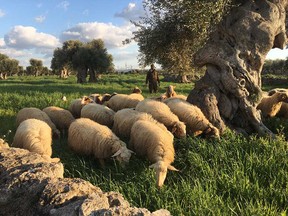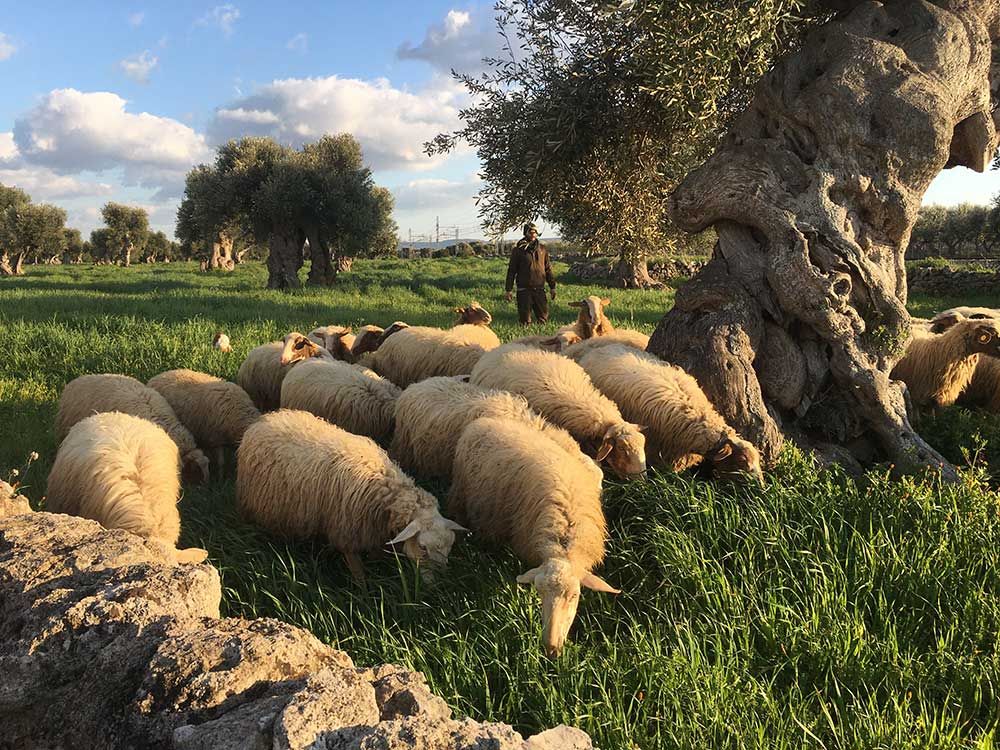[ad_1]
In The Lost Supper, Montreal-based writer Taras Grescoe explores how the flavours of the past could hold clues to safeguarding the future of food

Reviews and recommendations are unbiased and products are independently selected. Postmedia may earn an affiliate commission from purchases made through links on this page.
Article content
Silphion was once so precious it sat next to gold and silver in the Roman state treasury. The ancient Greeks and Romans prized the spice for its culinary and medicinal uses. With its fragrant resin and clusters of yellow flowers, the plant only grew in Cyrenaica (modern-day Libya). Until it didn’t.
Today, silphion is considered “the Holy Grail of food history,” says Montreal-based author Taras Grescoe, who chronicles its disappearance and possible rediscovery in his latest book, The Lost Supper: Searching for the Future of Food in the Flavours of the Past (Greystone Books, 2023).
Advertisement 2
Article content
Article content
As first-century historian Pliny the Elder wrote of silphion in his encyclopedic Natural History, “The single stem found within living memory was sent to the Emperor Nero. If an animal should ever come upon a promising shoot, the sign will be that a sheep after eating it rapidly goes to sleep, whereas a goat sneezes rather loudly.”
Since Pliny’s time, cooks have substituted asafoetida (or hing), the “(silphion) of Central Asia,” as food historians Andrew Dalby and Sally Grainger describe the fennel relative known for its sulphurous punch. That is, until the permanence of silphion’s extinction came into question in 2021, when Istanbul University pharmacognosy professor Mahmut Miski published a paper in the journal Plants about the discovery of Ferula drudeana, a rare species resembling silphion, in Anatolia.
“It’s reassuring that it’s a Lazarus species. It has lived on,” says Grescoe. “We can’t say 100 per cent this is exactly the same plant, but it’s looking pretty good. It ticks so many boxes, especially in taste and aroma, as well as the morphology.”
In 2021, on a quest for silphion, Grescoe travelled to the foothills of Mount Hasan, where two boys had led Miski to “several unusually tall Ferula plants” four decades earlier. The following year, he returned to Turkey with Grainger (“the Julia Child of antiquity”), gathering with Miski and others in Istanbul’s Nezahat Gökyiğit Botanical Garden for a taste test between asafoetida and Ferula drudeana.
Advertisement 3
Article content
“It was really amazing. It’s very hard to describe. It’s like a flavour enhancer with an amazing aroma. But it was like, ‘Oh, OK. This is what the Romans were trying to do,” says Grescoe of tasting Ferula drudeana.

As Grainger put it while recreating recipes from the Roman cookbook Apicius, which calls for silphion in dozens of recipes: “It’s intense and delightful. Earthy, I’d say, and mushroom ‘green.’ When you smell it, your saliva flows.”
The group devoured the Ferula drudeana version of aliter lenticulam — lentils with honey, vinegar, coriander and leek — but left its asafoetida counterpart largely untouched. The standout dish was ius in ovifero fervens, a sauce made with sweet wine and plums spiked with Ferula drudeana and served with lamb.
“What I love about it is, I love intensity of flavour. That’s what gets me out of bed. And a lot of the chefs that I admire the most love that too. And I think that’s adventure in the culinary realm — that’s true adventure. And knowing that the ancients had that sort of lust for intensity of flavour is really interesting because we’ve taken so much intensity out of our food,” says Grescoe.
Advertisement 4
Article content
“And that takes the intensity and joy out of life in a lot of ways. The savour. Food can transport you. It transports me all the time.”
Though humans had extirpated other species, silphion was the first extinction to be recorded. With the threat of lost food species continuing to grow, the lesson of silphion is as relevant today as it was centuries ago — whether the spice has a second chapter or not.
“Human appetite is completely capable of usurping species in the wild,” says Grescoe. Humanity is driving an unprecedented decline of biodiversity. Species are disappearing at rates hundreds of times higher than at any other point in the last 10 million years, he writes, citing United Nations data.
Culinary species are especially vulnerable, with a rate of extinction roughly five times as high as the standard. This is cause for concern because, as Grescoe emphasizes in The Lost Supper, “diversity is resiliency.”

In addition to biodiversity loss, food security is being threatened by climate change and geopolitical conflicts. As Grescoe illustrates, looking to the past can offer clues to safeguarding the foods of the future.
Advertisement 5
Article content
“Food security issues aren’t going to go away. There are so many crises coming to a head.” While some blame agriculture for the climate crisis, he says, there are lessons to be learned from traditional farming techniques and Indigenous ecological knowledge.
Indigenous peoples used controlled burns, for example, as both a fire prevention method and food management technique. Experts have recommended Canada expand prescribed burns as a way to prevent forest fires, The New York Times reports, but they’re difficult to get approval for.
A 2021 Simon Fraser University study published in Ecology & Society examined the forest gardens cultivated by Ts’msyen and Coast Salish peoples. Despite being untended for more than 150 years, these orchard-like plots filled with native fruit and nut trees, medicinal plants and roots continue to thrive.
Grescoe also cites instances of mariculture, especially the clam gardens of coastal First Nations, and the terra preta of the Amazon and parts of West Africa (patches of dark, fertile soil that are the result of human intervention). “That was the big revelation, and it came about halfway through the research of the book. That not only should we be looking to the diversity of foods in the past, but the diversity of farming techniques and irrigation techniques, and coexistence with the land.”
Advertisement 6
Article content
Drinking wine made from newly discovered, ancient grapes on the slopes of Mount Olympus and tasting extra-virgin oil pressed from a previously unknown olive variety in the northern Italian region of Lombardy sent Grescoe on the book’s culinary odyssey.
The Lost Supper follows his pursuit of flavour in the form of camas, which Coast Salish peoples cultivated with controlled burns; garum, the now-obscure, once-ubiquitous fish sauce of ancient Greece and Rome; the aforementioned silphion; and Wensleydale, the oldest named cheese in England.

Whether the rich tradition of edible insects in Mexico City, the plight of the Ossabaw Island hog (a critically endangered breed of Spanish pig that has lived off the coast of Georgia since the 16th century) or the efforts to save Puglia’s centuries-old, Xylella-infected olive trees, which once produced half of Italy’s olive oil, each chapter offers insights into food security, health and sustainability.
Pandemic travel restrictions made the book more domestic than Grescoe had planned. Research trips to far-off places such as South Korea (to investigate an ancient form of soy sauce still being made on one of the islands and other East Asian umami-rich flavourings) ended up being impossible. As a result, the book looked inward in a way he hadn’t anticipated. Focusing on being self-sufficient in his own kitchen, he brought lessons home from what he saw out in the world.
Advertisement 7
Article content
Grescoe had been baking his own bread for a few years before COVID-19 sparked a sourdough craze, but he gained a new appreciation for it during the course of researching the book. When we spoke one August afternoon, he was proofing a ball of ancient grain khorasan dough, hopeful that the temperature would be just right.
“I don’t know if I would have had the time to do that during the normal course of researching a book where it’s half travel for me and then half writing. This allowed me to start experimenting at home. And it’s really changed the way I eat and my attitude towards food.”
He and his family haven’t completely deindustrialized their kitchen, but they make most of their food from scratch. There’s a sense of autonomy that comes from making your own food, especially in an era of rising food insecurity, says Grescoe. Admittedly, it takes more time, but he estimates his food bills are a quarter of what they were before.
“I’ve taken a lot of these things to heart. I really got into fermentation, so I always have kombucha going. I’ve got my own kimchi made with the garum I fermented. Those things are harder sells for my wife and kids, but they’ll try them sometimes.”
Advertisement 8
Article content
In choosing the foods to focus on in the book’s nine chapters, Grescoe wanted to cover a diverse geographic spread as well as tell the history of humanity, going back to Paleolithic times with edible insects and the Neolithic period with bread in Turkey and elsewhere.

“I knew there would be a big focus on classical antiquity, because there are so many lost foodstuffs from Greek and Roman times. So, there’s the silphion and the garum. I wanted to come back to the New World and come back home, really. The home I grew up in, which was British Columbia, or Illahee Chuk, as nobody calls it,” he says with a laugh. (Illahee Chuk is a proposed new name for British Columbia, which means ‘where land meets water’ in Chinook Jargon).
As for edible insects — “the deep past of food but also the potential future of food” — Grescoe remains skeptical. In Mexico City, ancient delicacies such as ahuautle, the so-called “caviar of Mexico” made from the eggs of the water boatman, are still part of gastronomic culture. Elsewhere, they tend to be expensive, niche and hard to sell.
“Some of the most expensive things you’ll buy at the best restaurants (in Mexico City) are escamoles, the maguey worms, that kind of thing. And honestly, they’re really delicious. They’re beautifully incorporated into the gastronomy there. But it remains a novelty thing here, unfortunately.
Advertisement 9
Article content
“There are all kinds of cases you can make for it rationally. But that’s another thing. That’s all it comes down to, is just the idea of deliciousness as being a force in human evolution — and something that’s kind of neglected by anthropologists and archeologists. But we humans really go out of our way for deliciousness, for great taste. And I think it’s actually driven, at some points, the evolution or development of our species.”
In his own quest for deliciousness, Grescoe set out to recreate the flatbread that was once baked at the Neolithic site of Çatalhöyük, Turkey. He ordered a metate from a store in Oaxaca, Mexico after archeobotanist Lara González Carretero told him that the Mexican stone tool, used to grind grains and seeds, was the closest thing to a Neolithic saddle quern.

After about six hours of hard work, he had enough flour for flatbread. “That was incredibly labour-intensive. It was a one-time thing,” says Grescoe. He’s thinking about buying a stand mixer mill attachment but in the meantime, sources freshly milled flour from Seth Gabrielse’s Automne Boulangerie. “Every Friday, they mill their own locally grown grains. Some are grown on the Island of Montreal. It makes amazing bread. The enzymes are still quite alive, and it makes a real difference. You can taste the grass in the bread. It’s interesting.”
Advertisement 10
Article content
Grescoe also collaborated with Turkish-born chef Fisun Ercan, owner of Bika, a farm-to-table restaurant in Saint-Blaise-sur-Richelieu, Que. In Ercan’s clay-walled oven, they baked Paleolithic-inspired flatbread: a control batch made with whole wheat, and another made with Grescoe’s hand-ground emmer studded with a handful of wild mustard seeds (sold as khak-shir at Persian grocery stores).
“Tasting the bread was like going to Turkey. It was also like travelling into the past,” says Grescoe. “And that’s another thing I discovered with this book. People in the past had the same capacities — mental, physical — as we do. We tend to think that they were somehow less sophisticated, but they were amazing at solving problems. And you can kind of do that time travelling in your kitchen by imagining how they would have solved the problems and looking at the tools that they had available to them. And the big revelation is that, man, it tasted good,” he says, laughing. “It was worth it.”
-

Fight against fake cheese goes high-tech with microtransponders on Parmesan
-

How this 2,000-year-old curry offers insight into the global spice trade
Article content
[ad_2]
Source link


















































Comments
Postmedia is committed to maintaining a lively but civil forum for discussion and encourage all readers to share their views on our articles. Comments may take up to an hour for moderation before appearing on the site. We ask you to keep your comments relevant and respectful. We have enabled email notifications—you will now receive an email if you receive a reply to your comment, there is an update to a comment thread you follow or if a user you follow comments. Visit our Community Guidelines for more information and details on how to adjust your email settings.
Join the Conversation